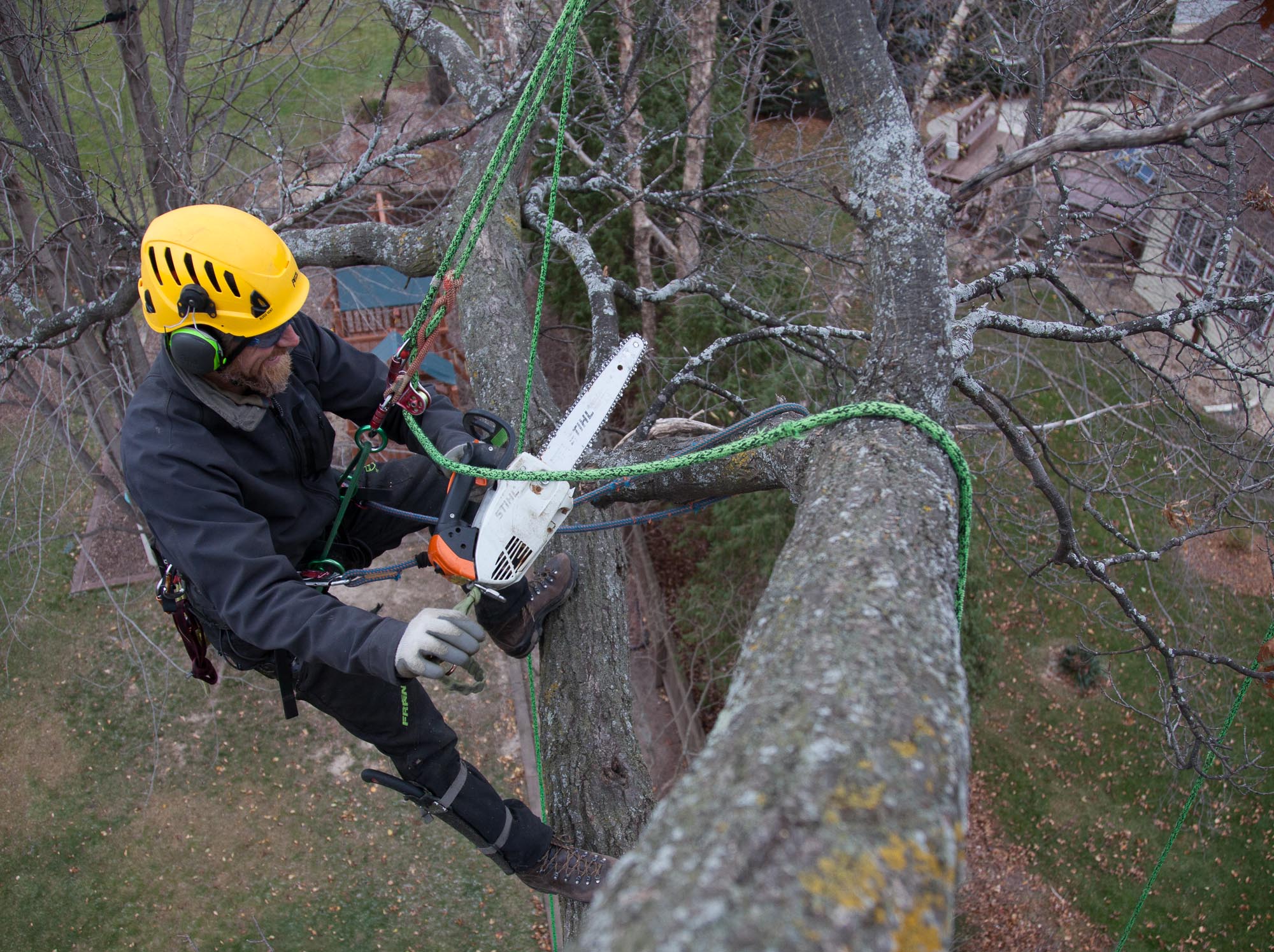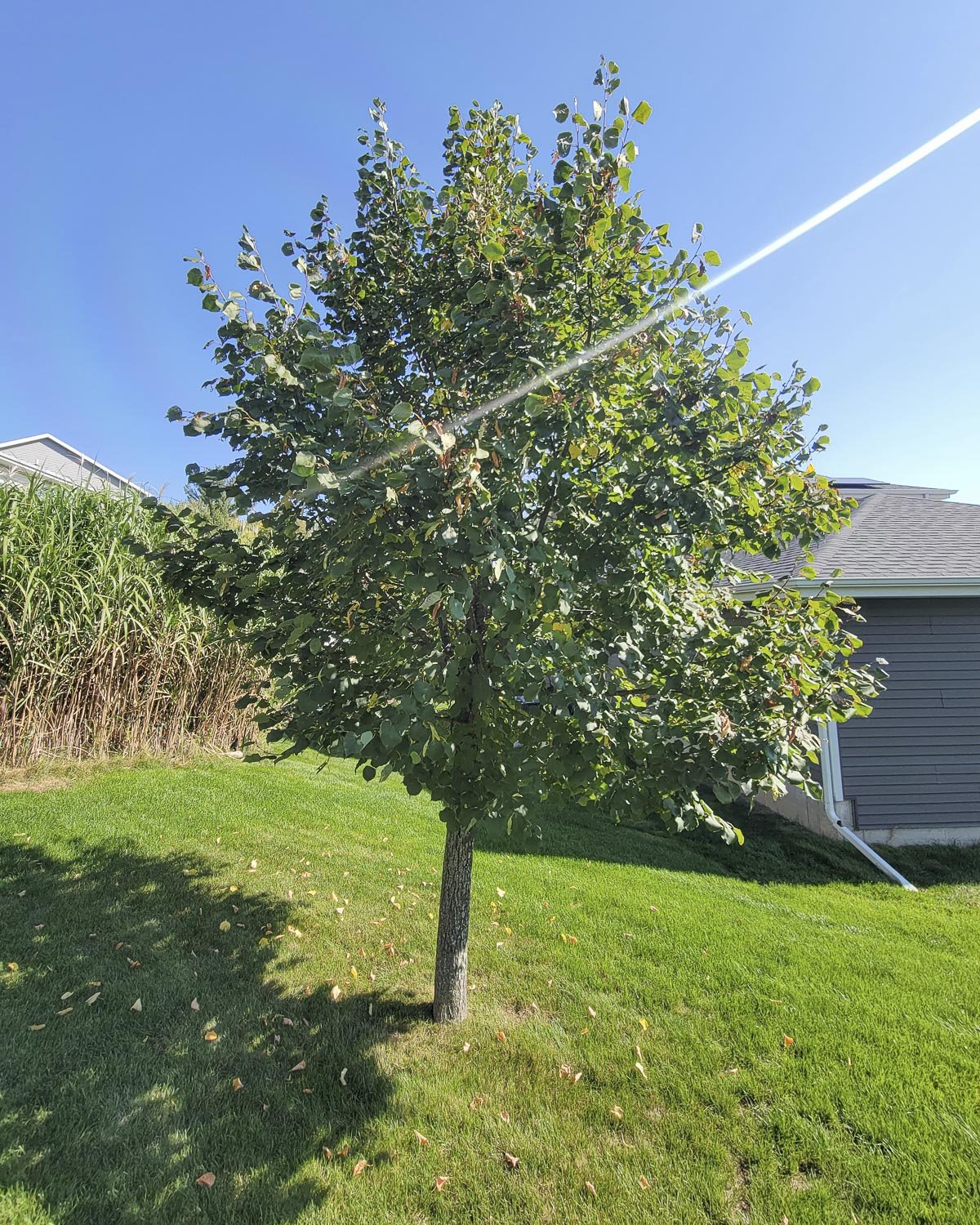Different Needs for Different Trees
Tree pruning (also called “tree trimming”) is the most important way property owners can care for a tree over the course of its life. Pruning a young tree gives it a healthy start and maximizes its benefits to your property. Maintaining good pruning practices minimizes storm damage and injury from falling branches. At the end of a tree's life, tree removal is the final pruning.
Structural Pruning for Young Trees
Giving trees early attention and care helps maximize their aesthetic shape, while minimizing your long-term expense.
Trees “know how to grow” in a forest, where most sunlight does not reach the forest floor. When you plant trees in an urban setting, however, the overabundance of sunlight relative to a native forest setting encourages trees to grow out (sideways), not up. Train pruning young trees attempts to simulate natural forest growth through branch management. Young trees have temporary branches and permanent branches. Keeping the temporary branches small for future removal, establishing a central leader (trunk), and also establishing permanent branching for the future canopy are the main goals of train pruning.
Before structural pruning
After structural pruning
Below is the general approach Heartwood takes to ensure your tree has the proper structure to thrive for decades to come.
Mature oaks sometimes requires walking WAY out on a limb.
Structural Pruning Goals
Establish a dominant central trunk
Remove diseased or damaged branches
Create proper branch spacing
Shorten lower branches that compete with central trunk
Establish an acceptable ‘skirt height’ (height of lowest branches)
Shorten temporary branches to control their size (diameter)
Establish permanent branches in upper canopy
Check for root flare/proper planting depth
Focusing on these principles will minimize future maintenance costs, reduce potential for storm damage, and reduce the need to remove large branches in the future. If you'd like to read more about structural tree pruning, check out Trees Are Good and the University of Florida's pruning tutorial.
Decorative Pruning for Shrubs & Small Trees
Saffron Sentinel® Cornelian-Cherry Dogwood flower buds
Thorough pruning is essential to maintaining shrub and decorative tree health, while also controlling size. Established plantings provide great visual interest, focal points for your landscape, and privacy from neighboring properties.
Oftentimes, property owners remove and replace neglected or overgrown shrubs with another similar shrub that will be overgrown again in 10-20 years. Stop the "feast or famine" cycle by using regular pruning to give the landscape an established look, while also saving you money over the long run.
Pruning small ornamental trees and shrubs, such as crabapples, lilacs, dogwoods, yews, and boxwoods, is essential for their health and vigor. Regular pruning of small trees and shrubs maintains an open form, controls their size, and ensures long-term plant health. We have extensive experience pruning these types of plants.
Specific benefits of pruning include:
Prevent foundation plantings from becoming overgrown and/or touching buildings.
Maintain proper spacing between each plant (excepting hedge situations).
Improve the longevity and quantity of flowers in flowering shrubs like lilac, dogwood, and witch hazel.
Maintain the health of your privacy screening and control its size. More frequent hedge or screening pruning ensures the screening remains lush. Infrequent pruning usually requires removal of more plant material, often leaving small holes or bare spots.
Return vitality to old shrubs in rough shape through rejuvenation pruning. Rejuvenation pruning not only improves shrub appearance, it also improves their vigor and health. This process removes one third of the largest canes and one third off the top to control height and allow for abundant new sprouts to grow.
The growth habits of each particular plant and your own specific needs dictate the pruning actions we take. For an overview of pruning small trees and shrubs, we suggest Purdue University's excellent pruning overview.
Mature Tree Pruning
Safety, tree health, and tree aesthetics are the goals of mature tree pruning. The general priorities are:
Remove dead or broken branches
Reduce potential for storm damage
Raise lower branches for clearance
Thin branches to increase light penetration through the tree (by client request)
Reduce branch end weight
Tree Climbing vs. Truck-Aiding Pruning
We take a different approach when it comes to pruning mature trees – no bucket trucks or cherry pickers here. Instead, we use a combination of ropes, saddles, and pulleys to climb trees, ensuring precision in our work.
Sometimes we use an aerial lift to safely access the outer edge of large canopies, or when tree stability is questionable during a removal. However, climbing is our strong preference and allows us to access every part of the tree, especially the interior. This hands-on approach enables us to make selective cuts tailored to the tree's health without compromising access.
Furthermore, climbing eliminates the need for bringing a big truck into your yard, preventing soil compaction. We prioritize Leave No Trace pruning, providing the best care for your trees while minimizing our impact on your landscape.
Arborist John climbing a mature tree with adequate safety gear
Brent climbing a rope during tree pruning operations
Arborists Zach and Garrett using lift to prune large dead limb from a mature maple
Safe Branch Removal
By using ropes and a ground crew, we can safely remove large branches with minimal damage to other trees, gardens, or turf. Customers may keep any resulting plant debris (for mulching, firewood, carving, etc.) if desired.
Fruit Tree Pruning
Pear tree
Fruit trees require special pruning attention to maximize a delicious harvest. Regular pruning helps ensure consistent annual fruit production and maintain the ideal size, shape and structure of the tree.
Why Fruit Tree Pruning is Important
Pruning opens the canopy to light and air circulation to help minimize disease. Tree structure and form can be improved and maintained by proper pruning. This can help protect your tree from branch failure during periods of heavy snow or fruit production.
Timing & Frequency
Pruning is scheduled for late winter while trees are still dormant to avoid injury from exposed pruning cuts. We sterilize our tools before working and between each tree to prevent the spread of disease.
Pruning of edible and ornamental fruit trees should begin the third year after planting. Ornamental fruit trees, such as crab apples, should be pruned every two to three years. Edible fruit trees, such as apple, pear and cherry, should be pruned yearly.









